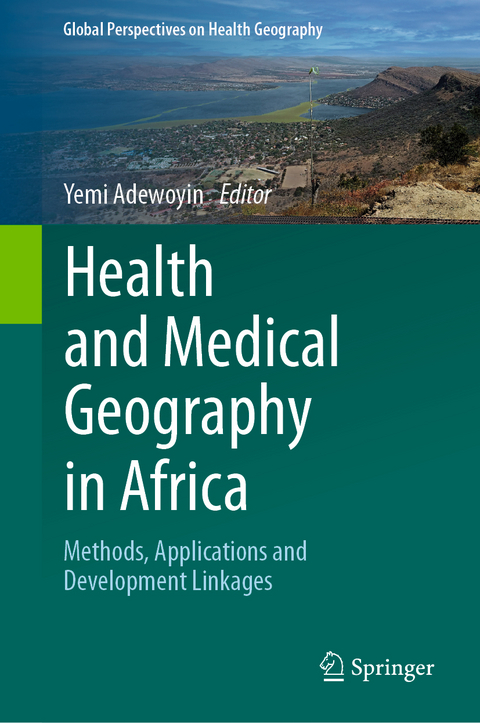
Health and Medical Geography in Africa
Springer International Publishing (Verlag)
978-3-031-41267-7 (ISBN)
This contributed volume focuses on the evolution and current state of the sub-discipline of health and medical geography in Africa. It encompasses theoretical and methodological issues as well as the current teaching and research capacities of institutions offering programs in health and medical geography in Africa. Further, the book will review the level of adoption of the sub-discipline in State policies and practice and also provide practical illustrations, with case studies, of how studies in the sub-discipline are central to the actualization of Africa's development agenda. Particular attention is paid to the relationship between health and development.
Through its direct and indirect impacts on labor productivity, population health and wellbeing matter for the social and economic development of households and national economies. Yet, health is not uniform in space. And so is development. Comparatively on many health and development indicators, Africa fairs poorly. The variation in health may present as differences in the occurrence and spread of diseases, the distribution of and access to healthcare facilities, and/or in health outcomes among the population. Reasons for these variations range from biology to the population's levels of exposure and susceptibility to elements in their environment, including the social interactions taking place within the environment.
The field of health and medical geography focuses on the spatial patterns and processes underlying these variations and provides pathways for understanding and addressing them. More specifically, the sub-discipline of health and medical geography focuses on, among others, how places (their characteristics and processes that go on in them) and environmental factors underlie and/or influence disease patterns, exposure and susceptibility to diseases, health variations, health behavior, health outcomes, and the provision of and access to healthcare services. This volume documents perspectives and applications in health and medical geography in Africa for academics, students, health practitioners, and development policymakers.
Dr. Yemi Adewoyin is a Lecturer in the University of Nigeria's Department of Geography as well as a Research Fellow in Population Health and Spatial Demography at the University of the Witwatersrand in Johannesburg, South Africa.
Chapter 1: Health, Diseases and Development - An Introduction to Health and Medical Geography in Africa.- Part 1: Nature, Perspectives and Methods.- Chapter 2: Philosophy, Questions and Methods in Health and Medical Geography in Africa.- Chapter 3: Medical Geography in Nigeria - History, Debates and State of the Discipline.- Chapter 4: Traditional and Non-Traditional Data Sources useful in Research in African Health and Medical Geography.- Chapter 5: Mixed Research Methods for Buruli Ulcer Prevention in Southern Benin using Geographic Health Surveys.- Part 2: Environment, Health and Disease.- Chapter 6: Spatial Analysis of Antiretroviral Therapy among Adults in Zimbabwe HIV: Geo-additive Bayesian Survival Models.- Chapter 7: Mobility and Disease Diffusion in East Africa - The Case of HIV/AIDS, Ebola and Covid-19.- Chapter 8: Management and prevention of HIV infection in migrant miners in Lesotho and South Africa: A capabilities approach.- Chapter 9: Geographical Analysis of Malaria in Nigeria - Spatiotemporal Patterns of National and Subnational Incidence.- Chapter 10: Antimicrobial Resistance in a Changing Climatic Context: An Emerging Public Health Threat in Africa.- Part 3: Health and Wellbeing.- Chapter 11: Climate-Related Diseases and Health Impacts of Climate Change in Sub-Saharan Africa.- Chapter 12: Spatial Distribution and Pattern Analysis of Women Sexual Violence in Tanzania.- Chapter 13: Associating Poverty with Gender-Based Violence (GBV) against Rural and Poor Urban Women (RPUW) in Cameroon.- Chapter 14: Menstrual Hygiene Management in the Context of Water Sanitation and Hygiene (WASH) Policies - A Case of Schools in Nigeria Health.- Chapter 15: The Nexus between Development and Early Childhood mortality in Nigeria.- Part 4: Location and Health Behaviour.- Chapter 16: Sanitation, Health Seeking Behaviour and Substance Use among Street Children in Ibadan, Nigeria.- Chapter 17: Human Geophagy (Soil Ingestion): Biochemical Functions and Potential Health Implications.- Chapter 18: Spatial Analysis of Breastfeeding Practices and Childhood Morbidity Episodes in Ghana: A Cross-Sectional Study of a National Dataset.- Chapter 19: Test-Tube Transnationalism: Fertility Migrants and Reproductive Refugees and the Provision of Care Across Southern Africa.- Part 4: Health Inequalities and Healthcare Planning.- Chapter 20: Location, Accessibility and Socioeconomic Correlates of Child Immunisation Coverage in Nigeria.- Chapter 21: Approaches to Defining Health Facility Catchment Areas in Sub-Saharan Africa.- Chapter 22: Access to Health Facility and Frequency of Antenatal Care Visits in Malawi using Bivariate Copula Regression Modelling.- Chapter 23: Territorial Study of the Distribution of Doctors in Gabon.
| Erscheinungsdatum | 01.11.2023 |
|---|---|
| Reihe/Serie | Global Perspectives on Health Geography |
| Zusatzinfo | XXIII, 499 p. 105 illus., 94 illus. in color. |
| Verlagsort | Cham |
| Sprache | englisch |
| Maße | 155 x 235 mm |
| Gewicht | 943 g |
| Themenwelt | Medizin / Pharmazie ► Pflege |
| Studium ► Querschnittsbereiche ► Prävention / Gesundheitsförderung | |
| Naturwissenschaften ► Geowissenschaften ► Geografie / Kartografie | |
| Schlagworte | Africa • Health inequalities • Health Outcomes • Regional Development • space and place • Spatial Epidemiology |
| ISBN-10 | 3-031-41267-2 / 3031412672 |
| ISBN-13 | 978-3-031-41267-7 / 9783031412677 |
| Zustand | Neuware |
| Informationen gemäß Produktsicherheitsverordnung (GPSR) | |
| Haben Sie eine Frage zum Produkt? |
aus dem Bereich


